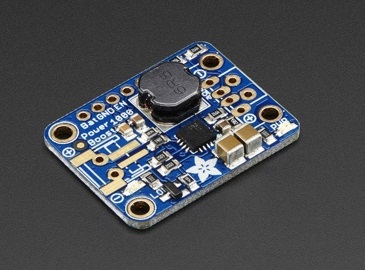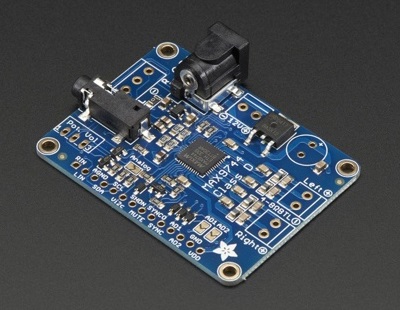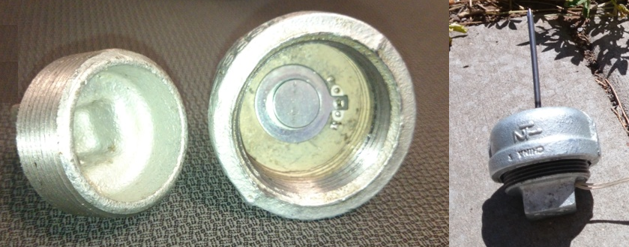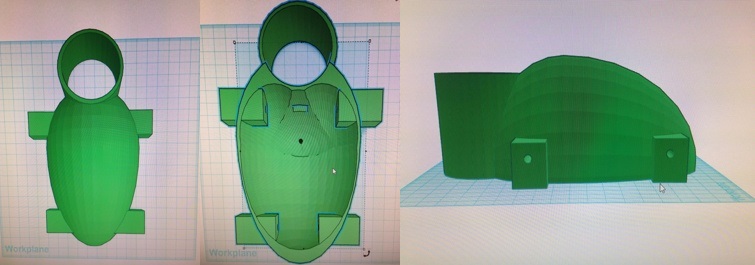Approach
Sketches
Hardware
Design Phase
Approach
After much research and planning, our group compiled a set of parts and systems essential to our device build. This included the materials, construction procedure, electronics, wiring and architectural design for use and operation. Parts where gathered throughout our private expense and ownership, provision of tools and test-measuring equipment where provided by the Electrical Engineering faculty at Northern Arizona University as well as the manufacturing of our housing through 3-Dimensional printing at the 98C building faculty. The parts, procedures and construction will be explained in detail further ahead.
Sketches

Rough sketches shown. Ideas developed by finding how the device needed to be attached to the tree. Shape of the housing, and attachment points where fundamental. Of these ideas, strapping, nailing, and screwing where considered the most for the design along with inducer placement.
Hardware
Much of the electronics where acquired through the open source provider, Adafruit Industries. These parts provide us a way to regulate and control the voltages needed to power the power-hungry components of the system. Two of the most important components would be the Raspberry Pi and the amplifier. Therefore, components such as the PowerBoost 1000, powers the Raspberry Pi by boosting the voltage of the battery source, to 5V from a typical lithium system consisting of 3.7V.

PowerBoost 1000
Another component, the DC-DC Adjustable Voltage Regulator, provides a significant boost of voltage to the amplifier, thereby driving the inducer. This part absorbs much more power, therefore it needed to have the option of voltage adjustability.

DC-DC Adjustable Voltage Regulator
Once the voltage is tuned to the output of 10V by the DC-DC Adjustable Voltage Regulator, this directly drives the 10V-minimum amplifier. This part is a highly adjustable component, which enables both digital and analog signals to be reproduced, along with multiple options for multi speaker configurations. For our design, the digital sampling and reproduction is done within the Raspberry Pi, therefore guiding the signal towards a DAC for amplification. This method eliminates the need of using any of the digital functions of the amplifier as optional features for the future.

Stereo 20W Class-D Amplifier
Our client, Dr. Hofstetter, provided us with several types of inducers. They varied from size, thickness, power, and weight. Originally, we had planned to use the largest of them all, an inducer that outputted the most wattage at the cost of weight and power. Therefore, we designed the entire device with large power bias to maximize operability and battery life so that if any future change of the inducer may occur, such as a smaller inducer, the system from here can only enhance its power savings.

Exciter/Inducer
Towards the end of the semester, it was originally planned to have the inducer installed in the enclosure, essentially making it an all-in-one device. Throughout design considerations, and ideas exchanged with Dr. Hofstetter, we decided to separate the enclosure containing the electronics and the inducer within a galvanized steel cap and plug for rugged protection for real time use, this along with a welded, protruded nail to install on trees for sound stimulation.

Steel Cap and Plug Inducer
With all the componeonts installed, the power sources where the next step to implement. This involves a solar panel of 6W rating, the solar controller, which controls and regulates power to operate the system all at the same time, charge the device during daytime, when night time occurs, the battery takes over as the power source to continue the audio emission with zero interruption throughout the day.

6W Solar Panel

Solar Lithium Charger

Lithium Ion Battery Pack - 3.7V 4400mAh
Our enclosure went through several designs, from box shapes, angular tops, and rectangular variations. But throughout the last weeks of the semester, Dr. Hofstetter recommended a final design to the enclosure that provided a small taste of what a beetle would look like, specifically a Weevil, of the Curculionoidea superfamily. Designed with CAD software, the final ideas of how the enclosure should look are shown below…

Deterrent Enclosure with top mount CAD
The green variants above shows a cylindrical, opening top which previously gave the idea of a structure containing the inducer. This would be installed on to the enclosure, giving the idea of an all-in-one system. But with ease of operation and maintenance in mind, we finally decided to separate these two pieces into two, separate units, solely connecting an audio cable between them with easy detachment ports.

Deterrent Enclosure, top mount removed, final design CAD
The yellow CAD diagrams above shows the final product for our project. The top mount was removed where it originally housed the inducer. The side ports hold the power switch, 3 ports on the bottom of the device for the speaker connections and solar panel jack. Along with internal "drawer-like" slots which hold the panel modules securing the electronic components as well as the battery.